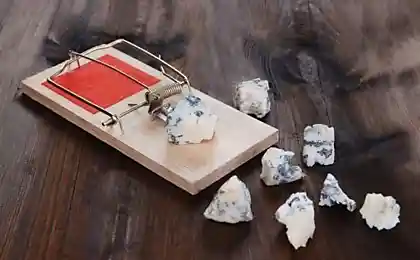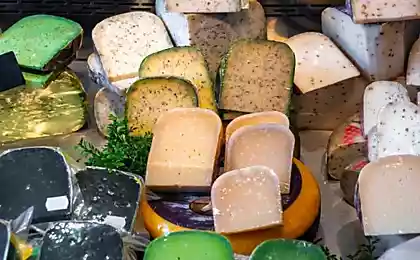166
Mother-in-law can not understand whether the cheese with mold has deteriorated or not, I go out for help
Cheese with blue mold or white - it does not matter, firstly, it is very tasty, and secondly, such cheeses are not less useful than all others. But the dangers are greater.
Today's edition. "Site" I want to know what the signs are that mould cheese has gone bad. People with a faded sense of smell, be careful!

I love brie cheese with white mold - soft, tender, creamy and pleasant to taste. I like to eat it in combination with sweet berries, croissants or baguette. I like to bake brie for dinner. It is very tasty to dip crackers into it, supplementing all this with fresh persimmon and hand!
Or more spicy cheeses with blue mold. Like Gorgonzola, Shropshire. And what is marble blue (Marble Bleu) - aged, with a rich nutty-pepper aroma and a long aftertaste. It is good in combination with dessert white or dry red drinks aged in cedar barrels. It is perfectly shaded by honey and sweet fruits, it is the king of cheese plates and an indispensable ingredient for cream sauces.

The mold on these cheeses is edible. For example, blue mold is penicillium. It inhabits such cheeses as gorgonzola and roquefort. White mold - yeast-like mushrooms Geotrichum candidum - covers brie, camembert.
These cheeses taste delicious. They are beautiful, and this mold is completely harmless. But it's only fresh cheese!

I have, like a fair smear with experience, a couple of times it was that there was a pink mold between the blue... It's beautiful, too bad to throw it away! But jokes, let's figure out how to identify fresh cheese with mold or it already has. expired.
First, buy cheese only in good checked places, when buying, look at the date of manufacture and expiration date. Secondly, pay attention to its appearance. For example, blue mold can be added pink (and this is certainly not food mold), such cheese begins to turn yellow outside. The light part can run.

See if there were any dark puddles or stains, and if the cheese itself did not begin to cry with mucus. Pay attention to the consistency of the cheese: is it different from the one that was originally made? For example, cheese began to crack and crumble, even though it was structural.
It is worth thinking about whether there is cheese if you feel a bright “fluffy” aroma. Blue cheeses have a rather bright and perhaps slightly sharp aroma, with sharp and mushroom notes. Cheese with white mold also have a mushroom smell, but it is softer and gentler.

Ammonia notes should not be present in the aroma of moldy varieties. If you feel such in cheese, then this product is unsuitable for food.
And the last sign is taste. Spoiled cheese becomes heavy to taste, there is no freshness in it. You might taste it. bitternessAlso expired cheese with mold very clearly pinches the tip of the tongue.
257440
I also suggest finding out how to bake brie cheese in the oven and what is better to combine it with. It is worth trying brie in different variations, so it goes into the category of favorites, revealing all the richness of taste!

To keep the cheese in your fridge longer, recommend in foil or specialized paper.
I love blue cheese, but I try to be careful with it. I don’t buy it very often and only in cheese shops. I'm looking at dates. But my mother-in-law was going to feed my son this cheese, but did not know how to distinguish a good product from a spoiled one. It's good that I got there in time and stopped her. Now she's rereading the signs of how to understand - fresh mould Or it went bad.
Do you like mold cheese? You give them to the kids?
Today's edition. "Site" I want to know what the signs are that mould cheese has gone bad. People with a faded sense of smell, be careful!

I love brie cheese with white mold - soft, tender, creamy and pleasant to taste. I like to eat it in combination with sweet berries, croissants or baguette. I like to bake brie for dinner. It is very tasty to dip crackers into it, supplementing all this with fresh persimmon and hand!
Or more spicy cheeses with blue mold. Like Gorgonzola, Shropshire. And what is marble blue (Marble Bleu) - aged, with a rich nutty-pepper aroma and a long aftertaste. It is good in combination with dessert white or dry red drinks aged in cedar barrels. It is perfectly shaded by honey and sweet fruits, it is the king of cheese plates and an indispensable ingredient for cream sauces.

The mold on these cheeses is edible. For example, blue mold is penicillium. It inhabits such cheeses as gorgonzola and roquefort. White mold - yeast-like mushrooms Geotrichum candidum - covers brie, camembert.
These cheeses taste delicious. They are beautiful, and this mold is completely harmless. But it's only fresh cheese!

I have, like a fair smear with experience, a couple of times it was that there was a pink mold between the blue... It's beautiful, too bad to throw it away! But jokes, let's figure out how to identify fresh cheese with mold or it already has. expired.
First, buy cheese only in good checked places, when buying, look at the date of manufacture and expiration date. Secondly, pay attention to its appearance. For example, blue mold can be added pink (and this is certainly not food mold), such cheese begins to turn yellow outside. The light part can run.

See if there were any dark puddles or stains, and if the cheese itself did not begin to cry with mucus. Pay attention to the consistency of the cheese: is it different from the one that was originally made? For example, cheese began to crack and crumble, even though it was structural.
It is worth thinking about whether there is cheese if you feel a bright “fluffy” aroma. Blue cheeses have a rather bright and perhaps slightly sharp aroma, with sharp and mushroom notes. Cheese with white mold also have a mushroom smell, but it is softer and gentler.

Ammonia notes should not be present in the aroma of moldy varieties. If you feel such in cheese, then this product is unsuitable for food.
And the last sign is taste. Spoiled cheese becomes heavy to taste, there is no freshness in it. You might taste it. bitternessAlso expired cheese with mold very clearly pinches the tip of the tongue.
257440
I also suggest finding out how to bake brie cheese in the oven and what is better to combine it with. It is worth trying brie in different variations, so it goes into the category of favorites, revealing all the richness of taste!

To keep the cheese in your fridge longer, recommend in foil or specialized paper.
I love blue cheese, but I try to be careful with it. I don’t buy it very often and only in cheese shops. I'm looking at dates. But my mother-in-law was going to feed my son this cheese, but did not know how to distinguish a good product from a spoiled one. It's good that I got there in time and stopped her. Now she's rereading the signs of how to understand - fresh mould Or it went bad.
Do you like mold cheese? You give them to the kids?
Chto communego at Maxima Galkina and Nikolaya Ciscaridze
Only a few will be able to compete with the great in the sharpness of mind, continuing unexpected and sometimes controversial quotes.























